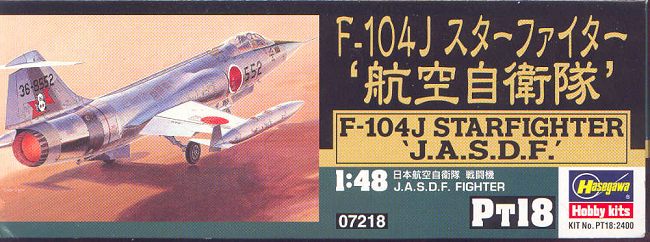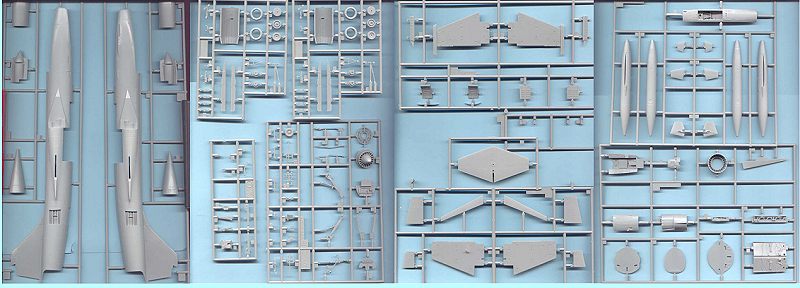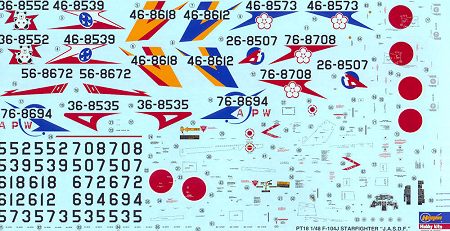
|
KIT: |
Hasegawa 1/48 F-104J |
|
KIT # |
PT 18 |
|
PRICE: |
¥2400 |
|
DECALS: |
See review |
|
REVIEW & |
|
|
NOTES: |
|

|
HISTORY |
In 1951, Kelly Johnson visited the fighter bases in Korea, to talk to the pilots. At the time, the Sabre pilots believed the MiG-15 was faster than the F-86A (it wasn't) and that it could outclimb them and had a higher ceiling (which it did). The pilots at Kimpo wanted a simple airplane that would fly faster and higher than the competition. They didn't want weight-inducing high technology that they believed prevented them shooting down the enemy; as no less a personage than Francis "Gabby" Gabreski said at the time: "all you need for a gunsight is a wad of chewing gum on the windshield." Johnson listened carefully, then returned to Burbank to give the pilots what they wanted. When the Air Force heard about it, the word was "Yes!"
The result was the F-104 "Starfighter." With a speed so fast that the limiting factor was the inlet temperature of the jet engine, the F-104 was called "the missile with a man in it," and for young lads like your reviewer who saw it sitting on the ramp at Lowry AFB in Colorado in 1959, it was the epitome of Fifties cool - right up there with a '55 T-bird.
Unfortunately, the very small wing which gave the F-104 its smooth supersonic flight, and the high T-tail that kept the controls from being blanked at a high angle of attack, turned out to be exactly wrong for an air superiority dogfighter at the low-to-medium altitudes all dogfights have taken place at in the time since the Sabre vs. MiG battles high over the Yalu fifty years ago. Indeed, when Johnson had the chance to redesign the airplane as the CL-1200 Lancer, he put the stabilizer low on the fuselage and a much larger wing high on the fuselage, the way it should have been in the first place.
Not only was the airplane wrong aerodynamically, it was wrong technologically; simplicity was not the answer, and the lack of all-weather capability severely restricted the use of the airplane. With its downward ejection seat, the early F-104A was a pilot-killer. By 1959, the Air Force was ready to junk its F-104As (but sent them to the ANG instead) and had cut way back on its order for F-104Cs. Comparative loss rates in the first 5,000 hours of operation was 7 for the F-100 Super Sabre and F-106 Delta Dart, 9 for the F-102 Delta Dagger, 11 for the F-101 Voodoo, and 14 for the F-104.
In a sales maneuver that can only be described as brilliant, Lockheed took the least-successful airplane of the Century Series, reworked it internally to the point where the only thing it had in common with the earlier airplane was shape, and in "The Sale of the Century" got it adopted as the premier Western strike fighter by NATO, and as the prime air defense fighter for the reconstituted Japanese Air Force. As the F-104G (F-104J in Japan), the airplane flew in large numbers for the next 25 years, with the last ones - the Italian F-104S - only being taken off operations at the end of the 1990s.(Editor's note: The AMI is still flying them as of June 2000. There are currently 4 Gruppo utilizing the F-104S ASA-M as well as older ASA versions and some TF-104Gs for training. They will be around until the Eurofighter comes on line.)
|
THE KIT |

Hasegawa has done the entire Starfighter family in 1/72 during the 1990s, and looks fair to do the same thing in 1/48 during the first decade of the 21st Century. Previously, the only 1/48 F-104s available were an F-104C and F-104G from Monogram - good at the time it was introduced 25 years ago but decidedly long in the tooth now - an F-104C from Revell, and an F-104 series from ESCI. These kits are all now effectively obsolete with the release of the new Hasegawa state-of-the-art kit of the F-104J. One can see in the engineering that an F-104G will come as well as the 2-seat TF-104G; the F-104C has already been announced for release in the near future.
The kit is state-of-the-art in crisp molding, with engraved panel lines and separated control surfaces. As I studied it, I noticed that it already comes with the larger tires and bulged gear door (a "bulge" so subtle that only the truly fanatical will ever spot it in the completed model) of the F-104G and F-104S, though at present it only has the Lockheed C-2 ejection seat (which all Starfighters except the F-104S carried at one time in their operational lives). The comprehensive decal sheet provides markings for every squadron to have flown the airplane in Japanese service.

|
CONCLUSIONS |
It may amaze some of you to know, but "Biplane Tom" has been an F-104 fan ever since I saw that F-104A sitting on the line at Lowry AFB that Armed Forces Day so long ago; the thing looked like it was going a million miles an hour sitting there! Just because I can't wait, this kit is going to become an F-104S (an easy modification using some sheet styrene and the Martin-Baker seat from a Monogram kit) with one of several commemorative schemes I have collected over the years (decisions, decisions...). It likely will not be the only one of these really superb kits to end up as a model on my shelves, either.
Note to aftermarket decal makers: I don't think it would be possible to come up with too many sheets of the really beautiful commemorative schemes that have graced this beautiful shape over the past 40 years. (hint, hint!)
Kit courtesy of Hobby Link Japan.
If you would like your product reviewed fairly and quickly by a site that has over 900 visits a day, please contact me or see other details in the Note to Contributors.